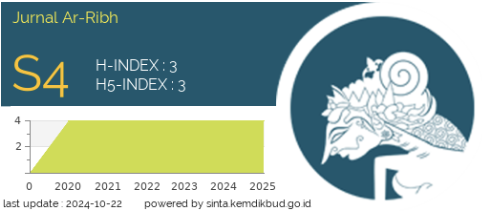Evaluating the Effectiveness of BAZNAS Zakat Distribution on Mustahik Welfare in Ajatappareng Using the CIBEST Model
DOI: https://doi.org/10.26618/jei.v8i1.13965
Abstract
Zakat distribution in Indonesia has generally been limited to material measurements, which often results in an imbalanced impact on mustahik , especially in the context of productive zakat. To address this gap, the CIBEST (Center for Islamic Business and Economic Studies) model is recognized as an effective tool for measuring both material and spiritual dimensions of welfare. This study focuses on productive zakat recipients ( mustahik ) under the auspices of BAZNAS in the Ajatappareng region, specifically in Parepare City and Sidenreng Rappang Regency. The research adopts a mixed-methods approach, combining quantitative and descriptive qualitative analysis, while using the CIBEST model to evaluate the impact of zakat distribution. Findings reveal that BAZNAS distributes both productive and consumptive zakat—including cash assistance, business equipment, and staple food—alongside training, mentoring, and empowerment programs. Based on the CIBEST quadrant analysis, significant shifts occurred in the material and spiritual poverty classifications of mustahik . Before receiving zakat, households were distributed as follows: Quadrant I (10 households), Quadrant II (22), Quadrant III (0), and Quadrant IV (3). After receiving productive zakat, the distribution changed markedly to: Quadrant I (29 households), Quadrant II (6), Quadrant III (0), and Quadrant IV (0). A paired-sample statistical test showed a significant difference in household income before and after zakat assistance, with a p-value (Sig. 2-tailed) of 0.000 (< 0.05). These findings confirm that productive zakat distribution by BAZNAS has a positive and statistically significant impact on improving the economic welfare of mustahik in the Ajatappareng region.References
Afriyanti, & Leny. (2021). Analysis the influence of productive zakat Pariaman City National Alms Agency to poverty reduction based on CIBEST model. Al-Ahkam Journal, 22(1).
Ali al-Sayis, M. Tafsir Verse Al-Ahkam, Vol. II. Beirut: Dar al-Fikr al-Ilmiyah.
Ariyani, S., & Yasin, A. (2022). Analysis impact productive zakat to welfare mustahik with Center of Islamic Business and Economic Studies (CIBEST) approach. Journal of Islamic Economics and Business, 5(1).
An-Nabhani, F. (2000). Sistem ekonomi Islam: Alternatif setelah kegagalan sistem kapitalis dan sosialis. Yogyakarta: UII Press.
Azwar. (2016). Zakat and social welfare. Journal of Islamic Economic, 5(2).
Badan Amil Zakat Nasional. (2020). Statistik zakat nasional 2019. Sub Divisi Pelaporan BAZNAS.
BAZNAS. Tentang zakat. https://baznas.go.id/zakat (diakses 12 Juni 2023).
Beik, I. S. (2009). Analisis peran zakat dalam mengurangi kemiskinan: Studi kasus dompet dhuafa Republika. Jurnal Pemikiran dan Gagasan, 1.
Beik, I. S., & Arsyianti, L. D. (2015). Construction of CIBEST model as measurement of poverty and welfare indices from Islamic perspective. Al-Istiqhad Journal, 7(1).
Busyro, W., & Razkia, D. (2020). Impact of zakat distribution in reducing poverty based on the CIBEST model (Case study at BAZNAS Pekanbaru City). Tabarru’: Journal of Islamic Banking and Finance, 3(2).
Canggih, C., Fikriyah, K., & Yasin, A. (2017). Potential and realization of Indonesian zakat funds. Al-Uqud: Journal of Islamic Economics, 1(1).
Dasangga, D. G. R., & Cahyono, E. F. (2020). Analysis of the role of zakat on alleviation poverty with the CIBEST model. Journal of Islamic Economics Theory and Application, 7(6).
Efendy. Peradaban Ajatappareng. https://www.kompasiana.com/effendysamuel/550e5d74a33311be2dba8225/peradaban-ajatappareng-pandangan-pribadi (diakses 10 Desember 2023).
EZ, F., & Senja, R. A. (t.t.). Kamus Besar Bahasa Indonesia Lengkap. Difa Publisher.
Huda, N., dkk. (2015). Zakat perspektif mikro-makro: Pendekatan riset. Jakarta: Kencana.
Jaili, M., Adnan, M., & Furqani, H. (2021). Analysis of the impact of productive zakat utilization on mustahik business income improvement based on CIBEST model (Case study on Baitul Mal Aceh). Jurnal Sharia Economic, 2(2).
KM Ali, Amalia, N. N., & Ayyubi, S. E. (2016). Perbandingan zakat produktif dan zakat konsumtif dalam meningkatkan kesejahteraan mustahik. Al-Muzara’ah Journal, 4(1).
Kamarni, N., & Saputra, Y. (2021). Distribusi dana zakat produktif dalam meningkatkan kesejahteraan mustahik di Kota Padang (Model CIBEST BAZNAS Kota Padang). Journal Taraadin, 1(2).
Kementerian Agama Republik Indonesia. (2014). Al-Qur’an dan terjemahannya. Jakarta: Beras.
Mashudi, D. (2012). Menuju era zakat profesional. Bandung: Sagara Publishing.
Mubarokah, I., Beik, I. S., & Irawan, T. (2017). The impact of zakat on poverty and welfare mustahik (Case: BAZNAS Jawa Tengah). Al-Muzara’ah Journal, 5(1).
Najed, N. H. (2019). Manajemen zakat: Ajaran, sejarah, dan pemikiran. Jakarta: Umpar Press.
Nidityo, L. N. (2014). Zakat produktif dalam meningkatkan kinerja produksi, motivasi, dan religiositas mustahiq (Studi kasus di BAZ Jatim). JESTT Journal, 1(9).
Nurhikmah. (2022). Analisis model CIBEST untuk mengukur kesejahteraan mustahik di BAZNAS Kabupaten Pinrang (Skripsi, Universitas Islam Negeri Alauddin Makassar).
Prabowo, H., dkk. (2016). Pemanfaatan zakat, infaq, shadaqah dan wakaf. Jakarta: Majelis Ulama Indonesia.
Rosadi, A. (2019). Zakat dan wakaf. Bandung: PT Remaja Rosdakarya.
Setiawan, S. R. D. (2020). Potensi zakat di Indonesia sangat besar, tapi... Kompas.com. https://money.kompas.com/read/2019/11/07/153000126/potensi-zakat-diindonesia-sangat-besar-tapi- (diakses 25 Mei 2023).
Sabiq, S. (2006). Fiqh as-Sunnah, Vol. I. Jakarta: Pena Pundi Aksara.
Saputra, M. B. D., & Advanced, C. (2023). Effectiveness of productive zakat distribution in the form of business capital assistance for mustahik welfare with CIBEST method approach. Journal of Islamic Economics, 8(1).
Sarwat, A. (2019). Zakat atas uang. Jakarta: Rumah Fiqih Publishing.
Syauqi, I., dkk. (2015). Construction of CIBEST model as measurement of poverty and welfare indices from Islamic perspective. Al-Iqtishad Journal, 7(1).
Sugiono. (2010). Metode penelitian pendidikan: Pendekatan kuantitatif, kualitatif, dan R&D. Bandung: Alfabeta.
Sugiono. (2012). Metode penelitian kuantitatif. Bandung: Alfabeta.
YC, Pratama. (2015). Peran zakat dalam mengatasi kemiskinan (Studi kasus: Program zakat produktif BAZNAS). The Journal of Tauhidinomics, 1.
Zuhdi, M. (1994). Masailul Fiqh. Jakarta: CV Haji Masagung.
Wikipedia. Ajatappareng. https://id.wikipedia.org/wiki/Ajatappareng (diakses 12 Desember 2023).
Wikipedia. Zakat. https://id.wikipedia.org/wiki/zakat (diakses 6 Juni 2023).














